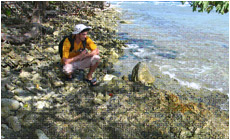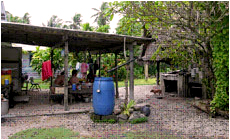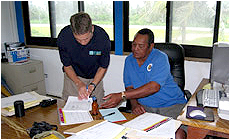Research Programs
GROUNDWATER AND AQUIFERS
Atoll Hydrologic Modeling
Why the Model was developed?
Water shortages are a persistent concern for residents of atoll islands. Normally, water demand is met by rooftop rain catchments, but prolonged droughts, such as those associated with ENSO events in the western Pacific region, can exhaust household storage, leaving residents dependent on groundwater or imported water. In response to the recommendation by the FSM Advisory Council meeting of October 23, 2006, WERI researchers have developed an accurate and practical saltwater intrusion and groundwater evaluation model for atoll islands in the FSM (Bailey et al., in press). Initial orientation to the model was presented in April and May 2008, in Yap, Chuuk, and Pohnpei, at which time WERI delivered copies of the model and supporting technical reports (Bailey et al., 2008a; Bailey et al., 2008b) to agency heads and policy makers who supported the project.
The current information transfer project follows upon the original orientation through a series of workshops for designated personnel in FSM state water resources agencies, as well instructors from the College of Micronesia and island high schools. The workshops will be delivered on Pohnpei, Chuuk, and Yap in one-and-a-half-day sessions during a two-week period in a series a pre-planned sessions at designated facilities. At this year´s Advisory Council meeting on September 16, council members specifically requested that systematic training be conducted on the model for designated users in each of the states with atoll islands. Users of the model will include local government water resource managers, environmental staff, and educators (Item III.1, Education and Professional Training, FSM Critical Water Resources Research, Education and Training Needs, September 16, 2008).
Methods & Objectives

End-users will be trained by WERI instructors on how to operate the model and apply it to estimate the responses of atoll island aquifers in the Caroline Islands to expected types of seasonal and inter-annual changes in rainfall. During summer 2009, the authors of the model will visit Yap, Chuuk, and Pohnpei to train the end-users of the model so that they can independently apply it and interpret the results. Such use may include forecasting the effects of changes in rainfall on atoll islands affected by significant natural events such ENSO-driven droughts, tropical storms, or wash-over events. A second objective is to establish an ongoing technical support relationship between the authors and end-users so that there will be a continuing dialogue to support continued successful use and application of the model to water resource management in the FSM. The model can run on lap-top or notebook computers. A published WERI technical report serves as an operator´s manual for the model (Bailey et al., 2008a), and another as an educational text on atoll island hydrology and modeling (Bailey et al., 2008b).
Back to top ^
Why This is Important Locally

Western Pacific atolls can go almost entirely without rain for months during severe droughts associated with ENSO events. When fresh water supplies from rain catchments become exhausted people must turn to groundwater, which is usually retrieved from hand-dug wells. However, during such drought conditions, there is little recharge to the groundwater, so the thin freshwater lens can become contaminated with sea water. Atolls are also vulnerable to wash-over events, especially during times of heightened sea-levels and storm passage. Flooding of the island by sea water can displace many or all of the residents and ruin crops and infrastructure, and may leave the shallow aquifers contaminated with salt water even after residents could otherwise return and resume normal activity. The model provides a tool for managers and planners to estimate how the fresh water lens in specified atoll islands in the FSM may respond to given changes in recharge. Specifically, the model provides a means of calculating lens thickness, and hence the groundwater reserve that can be expected on islands of given dimensions and other known properties for specified rainfall.
Improving water resource availability and sustainability on small island communities promotes economic and social stability, as well as preserving the preferred way of life for many current and future residents of the FSM. Inclusion of island science educators in the training provides for improved long-term education of students as well as the public at large on island hydrology and water resources management.
Back to top ^
References
- Bailey, R. T., J. W. Jenson, and A. E. Olsen, 2008a, An Atoll Freshwater Lens Algebraic Model for Groundwater Management in the Caroline Islands: WERI Technical Report No. 120, Mangilao, Water & Environmental Research Institute of the Western Pacific, University of Guam.
- Bailey, R. T., J. W. Jenson, and A. E. Olsen, in press, An algebraic model to predict the freshwater lens thickness of an atoll island: Groundwater.
- Bailey, R. T., J. W. Jenson, D. H. Rubinstein, and A. E. Olsen, 2008b, Groundwater Resources of Atoll Islands: Observations, Modeling, and Management, Mangilao, Water & Environmental Research Institute of the Western Pacific, University of Guam.
Back to top ^










